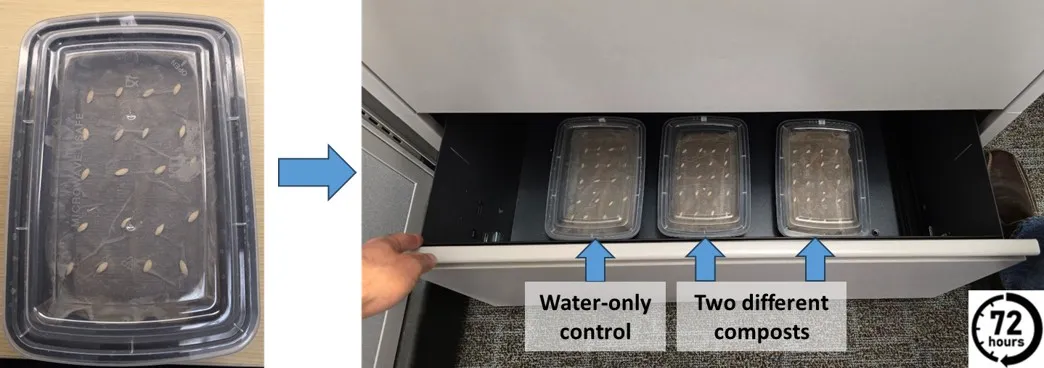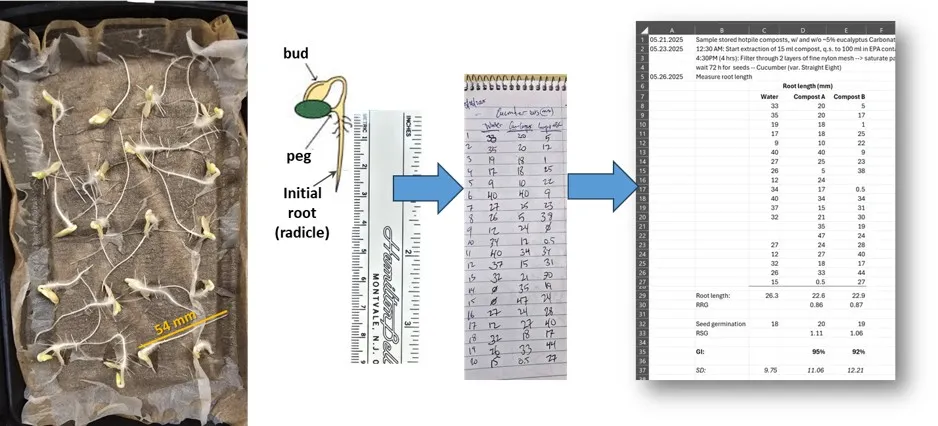The cucumber germination index (GI) test is a widely used bioassay to evaluate compost maturity by assessing its phytotoxicity and suitability for plant growth. Below is how we conduct the test of composts made at the UCCE Santa Clara Compost Demonstration site in San Jose. You can develop your own variation depending on available materials. Just be sure to be consistent.
Steps to Perform the Cucumber Germination Index Test
1. Prepare the Compost Extract:
- Mix a sample of the compost with distilled water. We add 15 mL of sifted compost to a jar that has a 100 mL mark and then add water to bring it to the 100 mL level. (Note: We work with volumes rather than weights since the water content of composts can vary considerably. Measurements are made with metric measuring spoons).
- Secure the jar lid and shake vigorously; allow the suspension to sit at room temperature, shaking occasionally over the next 4 hours.

2. Filter the Compost Extract:
- Filter the mixture using a fine mesh or filter paper into a cup or glass to remove particulates from the extract. We use two layers of nylon mesh laundry bags.

3. Set Up the Test:
For each extract and control to be tested:
- Place two layers of paper towels on the bottom of each container. You will need one container per extract plus one extra container for a distilled water-only control. We use rectangular take-out food trays with lids, having the bottom dimensions of 12 mm x 18 mm.
- Add 15 mL of liquid (i.e. filtered extract or water) and tilt to ensure uniform moisture over the paper towels.
- Place 20 evenly spaced cucumber seeds on top of the paper towel.
- Place 1-ply of tissue paper, cut to the bottom dimensions of the container, over the seeds and wet with an additional volume of the same liquid (e.g. 2.5 mL).

4. Incubation:
- Place the lids on the containers (without making them air-tight) and incubate in the dark at room temperature for 72 hours.

5. Measure Germination and Root Growth:
- Count the number of seeds that germinate in both groups.
- Measure the root lengths of seedlings in each group.

6. Calculate the Germination Index (GI):
The GI combines seed germination percentage and root elongation relative to the control group. It is calculated as:

Interpretation
- A high GI (>80%) indicates that the compost is mature and relatively free from toxic substances like ammonia, soluble phenolic compounds, or volatile organic acids.
- A low GI indicates an immature compost with phytotoxic compounds that inhibit seed germination and root growth. Further curing (or further composting if the GI is <50%) is needed before using the material around plant roots.
This test is simple, cost-effective, and provides valuable insights into compost quality, making it a standard method for assessing compost maturity.
Adapted from: Buchanan, M. (2001). Compost maturity index. California Compost Quality Council. https://woodsend.com/wp-content/uploads/2019/09/Compost-Maturity-Index_CA-Compost-Quality-Council_Buchanan_Brinton_2001.pdf
